
DNA
Gold Found in Genetic Desert
Off to a Great Start
- Berkeley Lab Runaround
DNA Gold Found in Genetic Desert
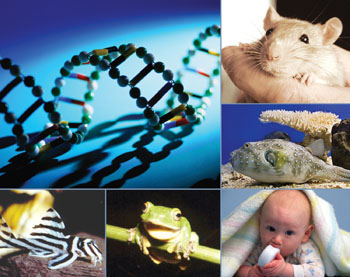 |
|
| DNA sequences that activate genes from distant locations were discovered in regions of the genomes of humans, mice, frogs and both puffer and zerba fish thought be genetic deserts. | |
BY LYNN YARRIS
Vast regions of the human genome thought to be genetic “deserts” harboring DNA sequences of no value may actually contain heretofore hidden nuggets of DNA gold. A team of researchers at Berkeley Lab and the Joint Genome Institute (JGI) compared DNA sequences from gene deserts in the genomes of humans, mice, frogs, and fish and discovered sequences that regulate the expression, or activation, of genes over surprisingly long distances.
“The distance from which these long-range enhancers can reach out across the genome to regulate a gene is a hundredfold greater than anyone thought,” says Edward Rubin, M.D., who led this research. “Gene deserts may not be home to any genes, but they can host DNA sequences that act as long-distance switches to activate far away genes. This suggests that the idea that all gene deserts could be eliminated with no consequences to the organism is wrong.”
Rubin is director of Berkeley Lab’s Genomics Division and of
the JGI. As a research geneticist, he has been a pioneer in the study
of the evolutionary conservation of noncoding DNA sequences that play
an important role in regulating gene expression. The results of his
latest finding are reported in the Oct. 17, 2003 issue of Science.
Co-authoring the Science paper with Rubin were Marcelo Nobrega and
Veena Afzal of Berkeley Lab and JGI and Ivan Ovcharenko, now with
Lawrence Livermore National Laboratory.
Earlier work led by Rubin established that comparative analysis techniques
used to identify genes — sequences of DNA bases that code for
proteins — in humans and other vertebrates can also be used
to identify DNA sequences that regulate genes.
He explains the principle as this: “If evolution conserved a
sequence over the millions of years since humans and other vertebrates
diverged, it likely has a function. Whether this function is to code
for a protein or to regulate gene expression, we should be able to
identify these sequences through genomic comparisons.”
In this latest research, Rubin and his Science co-authors applied the principle of conserved noncoding sequences to gene deserts. Genes are distributed in clumps throughout the 3 billion DNA bases that make up the human genome. It is estimated that as a result of this uneven distribution, approximately 25 percent of the genome is a genetic wasteland, made up of gene deserts that stretch out more than 500,000 bases in length. Because gene deserts were thought to contain nothing of importance, they have gone largely unexplored.
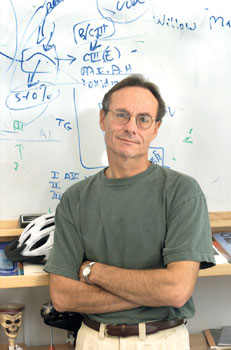 |
|
| JGI Director Eddy Rubin |
“We went into one of these deserts looking for a gene regulatory element that could regulate from far away, something that has been conserved by evolution since humans and fish shared a common ancestor,” Rubin says.
He and his co-authors focused on a human gene called DACH1, which is involved in the development of the brain, limbs and sensory organs and resides between two large gene deserts. Because there have been few regulatory elements found near the DACH1 gene, Rubin speculated that such elements might be located in the surrounding gene deserts.
To identify evolutionarily conserved “footprints” that might correspond to possible DACH1 enhan-cers, Rubin and his co-authors compared more than 2.5 million DNA bases from the human DACH1 gene and its desert neighbors to the bases in their mouse genome counterparts. They identified more than a thousand conserved noncoding sequences, meaning sequences at least 70 percent identical in both species over at least 100 bases. They then determined which of these sequences had also been conserved in the genomes of the frog, the zebra fish, and two types of fugu, or puffer fish. This reduced the number of conserved noncoding sequences to 32. A series of in vivo testing was then used to identify seven long-range gene enhancers buried in the deserts on either side of the human DACH1 gene.
The findings in the Science paper indicate that future studies aimed at understanding the way genes are expressed in the human genome and how they function may have to expand the DNA sequence territory taken into consideration. The findings also hold implications for the treatment of diseases.
Explains Rubin, “Regulatory elements that are very far away
from a gene can cause serious problems. You can think of these long-range
enhancers like the root system of a tree. Previously we thought that
roots only extended a short distance from the tree. Our new study
suggests that some roots can extend far away from the tree’s
trunk and branches. Cutting those distant roots can still do harm
to the tree.”
Off to a Great Start - Berkeley Lab Runaround
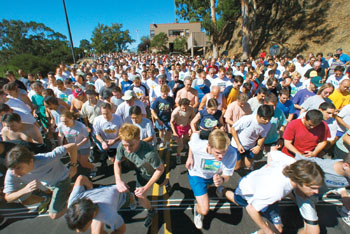 |
|
| “Don’t run me over!” yelled Roy Kaltschmidt, the Lab’s senior photographer, as hundreds of Runaround participants jumped from the start line. Standing a perilous five feet in front of them, the 6’5” Kaltschmidt raised his camera over his head and fired about five or six shots in each direction as the stampede veered around him. “I got belted once as someone ran into me,” he laughed, apparently still in one piece. The photograph above is ample proof he walked away with his life — and some nifty shots. | |
BY MONICA FRIEDLANDER
A near-record number of participants — 754 runners and walkers plus about 20 bicycle riders — participated in the annual Berkeley Lab Runaround,.“This was the largest turnout in six years and the third highest ever,” said event coordinator Steve Derenzo.
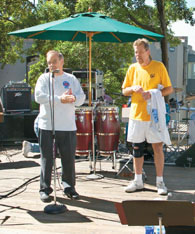 |
|
| Mark Levine and Bo Bodvarsson, shown here at the post-run ceremony, headed an exciting divisional competition in this year's Runaround. | |
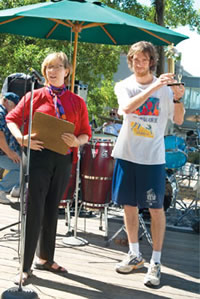 |
|
| Sally
Benson presents the winner, Dula Parkinson. He holds his trophy
after having won the race for the second consecutive year. The
proud winner got to enjoy the spoils of victory this time, unlike
last year when school duties summoned him back to campus before
the awards ceremony was held. More Runaround pictures |
Winners were Dula Parkinson, a graduate student in Physical Biosciences, with a time of 10:05, and Susannah Tringe of the Geno-mics Division, with a time of 13:15. Parkinson also won the race last year. Deputy Lab Director Sally Benson presented prizes to the winners in the various serious, fun, and outright whacky categories (including snazziest shoes, youngest baby, best legs on a man and biceps on a woman).
The fun atmosphere did not preclude fierce rivalries that would put Olympic competitions to shame. Only days before the event, the Earth Sciences Division (ESD) officially challenged Environmental Energy Technologies (EETD) to a divisional competition pitting the five fastest runners from each division. Hence a race between the proponents of more efficient energy tools and improved air quality versus the team digging for solutions to environmental remediation and global climate change.
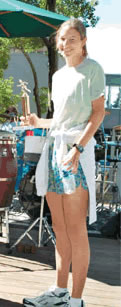 |
|
| Susannah Tringe was the first woman to cross the finish line, with a time of 13 minutes, 15 seconds. | |
Bo Bodvarsson, head of ESD, felt pretty secure that his team had an inherent advantage over EETD, whose team, he told EETD head Mark Levine, is focused on “indoor stuff, perhaps something to do with couches and comfortable chairs.” Moreover, Bodvarsson added, because of EETD’s concern with air quality, “many of your scientists might be reluctant to breathe fast and furiously.”
Quipped Levine, “Some of us resent your mention of our indoor activity. Phil Price, for example, spends a lot of time running around creeks and sometimes being up them. Many of us — and I proudly count myself among them — have gotten in terrific shape running to catch airplanes. And some of us are truly in great shape from our inexhaustible efforts to save the world.”
Fate, however, sided with the outdoorsy ESD team over their indoor counterparts. What’s more, Bodvarsson’s team holds the distinction of having its five best runners finish in the top 20 overall. The race for moral high ground will have to be decided at a later time. The prize for the victors: the loser team shall treat the winner and his teammates to a barbecue. Many Olympians should be so lucky.
Final results will be posted on the Runaround website.
|
|
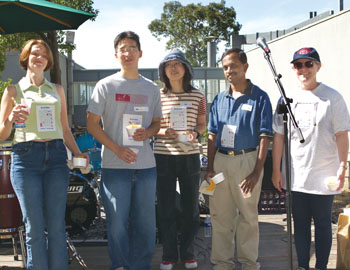 |
|
| As in past years, a fun highlight of the Runaround was the march of the centipede — the “Building 64 Codons” this year — manned by members of the Physical Biosciences Division (Building 64 denizens). Explains Libby Holbrook: “The genetic code also consists of 64 codons. And each individual wore a nametag indicating an amino acid or start or stop codon as part of a peptide.” The team included (pictured here) Liliana Stefan, Stanley Lee, He-Shu Lu, Wasantha Ranatunga, and Libby Holbrook, and (not pictured) Makio Tamura and Steve Holbrook. | |
Open Enrollment ‘Round the Corner
Cost Increases, New Online System
BY D. LYN HUNTER
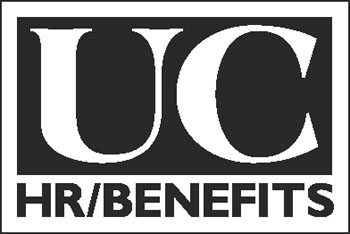 |
IIt’s that time of year again, when most of us need to start thinking about our health benefits and changes we may want to consider. Open Enrollment starts Nov. 1 and runs the full month. This year employees will face significant changes to the Lab’s medical plans in light of rising health care costs, and the Lab is planning various information sessions to help employees navigate through the maze.
Health benefits are one of the most valuable perks of working for the University of California, which is why November is such a crucial month for all UC employees, including those at Berkeley Lab.
During the entire month of November, staff can participate in the annual Open Enrollment to make changes to health plans and related benefits. And there’s a lot to consider this year, primarily because the cost of health insurance has dramatically increased, and employees will be asked to pay more as a result.
“Insurance rates across the country have gone up for a number of reasons,” says Richard Takahashi, the Lab’s benefits coordinator. “Among them are the higher cost of prescription drugs, new medical technologies, and the aging workforce.”
Compounding the difficulties for UC employees is the state budget crunch, adds Takahashi. Although the University will cover 65 to 95 percent of employee insurance costs next year, it cannot pay for all the increases (a gross 15 percent bump), due to severely limited funding from the state.
However, in an effort to mitigate the financial impact on staff, he explains, the University has raised costs based on employee salaries. For example, the increase for someone who makes less than $40,000 a year will be much less than that for an employee who makes over $120,000.
“Last year, the University used a two-tiered system, with cost increases adjusted for those who made over or under $40,000,” says Takahashi. “This year, it was broken down into four tiers within the $40,000 to $120,000 range.”
This allows the University to spread out the costs and to lighten the load on those who can least afford the increases, he says. For example, an employee making under $40,000 a year who uses Kaiser will have 98 percent of the cost covered by the University. Also, though costs have increased, no insurance provider services have been cut.
UC will continue to cover 100 percent of the premium cost for dental and vision coverage for employees and their eligible family members. Additionally, employee costs for some non-medical plans, including life and disability insurance, are decreasing in 2004.
Details on these changes are outlined in the Open Enrollment brochure, to be mailed in late October. Specific cost increases for various health plans and salary ranges are listed in the chart below. To learn more about the changes in health plan costs and options, employees are invited to attend the Lab’s Open Enrollment Vendor Fair and information sessions (see box for schedule) or by visiting UC’s “At Your Service” web-site (http://atyourservice.ucop.edu/).
Other Changes
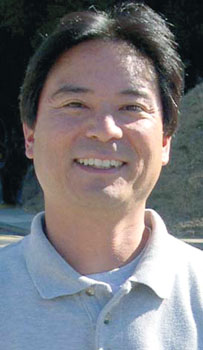 |
|
| Richard Takahashi | |
In the past, employees adjusted their health plans during Open Enrollment
by telephone. This year, the university has switched to a web-based
format. Staff can use computers at home or work (as long as they have
an Internet connection) to make changes. Instructions on how to use
this new online system are included in the Open Enrollment brochure.
“The vast majority of UC employees prefer making transactions
online,” says Takahashi. “It’s faster, they can
see the information right in front of them, and it minimizes mistakes.”
Staff who don’t have access to computers can use designated machines in the computer lab, located in Building 51L. (See the calendar.) Those needing further assistance can contact the Lab’s Benefits Office at X6403.
Another major change to next year’s benefits package is a switch in legal plans. Starting next year, service will be provided by ARAG, not Signature. Takahashi said the shift was made because ARAG provides a more comprehensive suite of services. Employees can opt into the new legal plan during this year’s Open Enrollment.
Read Your Information
Employees who don’t want to make any adjustments to their health plan need not take any action, unless they have Health Care or Dependent Care Reimbur-sement Accounts. However, Takahashi warns, everyone is encouraged to thoroughly review the Open Enrollment brochure so they understand the changes that will to take place starting Jan. 1, 2004. Staff who have not received their packets by late October should contact the Benefits Office at X6403 or benefits@lbl.gov.
“These are difficult times for everyone,” says Takahashi.
“But the University understands how important health insurance
is for its employees. They have worked hard all year to find a way
to provide the best coverage at the most affordable price.”
Lab Light Kits Teach Middle School Students
BY DAN KROTZ
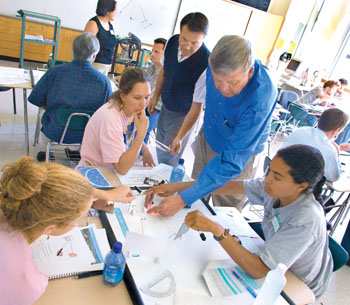 |
|
| CSEE's Rollie Otto (in back) and Dale Koistinen put Berkeley Middle School teachers through their paces with hands-on light kit demonstrations developed at Berkeley Lab. |
A mirror, a laser pointer, and a prism. On Monday, several kits containing these and other thought-provoking items were given to science teachers from the City of Berkeley’s Longfellow, Martin Luther King, and Willard Middle Schools.
Berkeley Lab’s ‘properties of light’ kit, designed to give seventh and eighth graders a first-hand glimpse of how the angle of incidence equals the angle of reflection, grew out of a collaboration between the Lab and the Berkeley Unified School District to strengthen and update the district’s science program.
“We are creating and supporting a partnership with Berkeley Lab as a science-rich resource for teachers and students,” says Rollie Otto, head of Berkeley Lab’s Center for Science and Engineering Education.
The Lab is helping the school district align the content of its science curriculum through the grades — what students learn in middle school lays a foundation for what they’ll learn in high school. This not only applies to fundamental concepts in life sciences and physics, but also to basic science skills such as how to develop experiments and present their results.
“We are working with teachers to help them find ways to work
across the grade levels,” Otto says.
In this vein, the light kits were developed by Lab employees to give
seventh graders a chance to see how light works. They’ll later
use this knowledge in the eighth grade when they learn about astronomy
and space exploration, which, in turn, will lead to high school lessons
on the physical properties of light in chemistry.
The light kits stem from an August meeting in which Berkeley middle
and high school science teachers chose one lesson that will lead to
more advanced concepts taught later in the curriculum. The kits will
be given to about a dozen middle school science teachers in the district,
or one for every seventh and eighth grade science class. Similar kits
exploring other scientific concepts are planned for the future.
Short Takes
Road to Nobel Prize Winds Through ALS
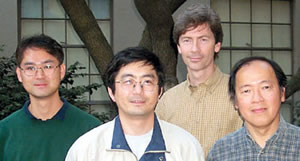 |
|
| Bing Jap (far right) is pictured with members of his working group: (left to right) Bong-Gyoon Han, Haixin Sui, and Peter Walian. | |
A few weeks ago, during a brief visit, Roderick MacKinnon was one of many scientists working at the Advanced Light Source (ALS). Last week, the biophysics professor from New York City’s Rockefeller University won the Nobel Prize in chemistry. The ALS’s brush with fame is no coincidence. MacKinnon’s prize-winning foray into the properties of ion channels in cell membranes was fueled in part by research conducted at ALS beamline 5.0.2. His research was supported by members of Bing Jap’s Life Sciences group. In fact, Lab researcher Haixin Sui is cited in the advanced information prepared by the Nobel Foundation. MacKinnon also conducted research at the National Synchrotron Light Source and at the Cornell High Energy Synchrotron Source.
A Digital Dinner
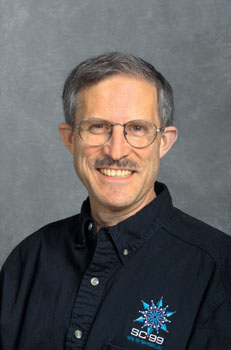 |
|
| David Bailey |
At a recent San Francisco dinner hosted by business leader Steven Forbes, publisher of Forbes magazine and former presidential candidate, David Bailey of the Computational Research Division had a chance to mingle with two dozen top Bay Area executives, with whom he discussed the impact of advanced computers and new-generation Internet tools on the day-to-day work of scientists. To Forbes, Bailey posed the question of how government and industry can head off a public backlash against cutting-edge technologies and mitigate the looming digital divide, given that startling advances in computers, biotechnology, and nanotechnology keep coming rapidly. Forbes answered at length, emphasizing the need to “democratize” technology as rapidly as possible, just as Henry Ford did with the automobile, so that “the exotic and fearful become commonplace and accepted.” He also noted that the U.S. has to recognize it is not the leader in every technology and that it has some catching up to do — for example, with the Europeans in cell phone systems and with the South Koreans in accessibilty of broadband Internet connections.
Mail Models
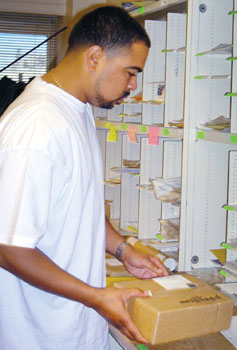 |
|
| Chris Blanchard sorts mail in Building 69. | |
Through rain, hail and thick fog, the Lab’s Mail Services Department works tirelessly to deliver parcels and letters to staff across the Hill in a timely fashion. A tiny crew of five people housed in the Mail Room in Building 69 make it all happen. With their deft hands, they sort up to 1,000 pieces of internal and external mail each day, often turning it around in as little as one to three hours, depending on when it’s picked up, according to Mario Cole, the customer service supervisor. “We strive to never make mistakes,” he says. “But we do occasionally misread a mail stop.” Despite the growing use of electronic communications, Cole says the flow of mail through his department has remained steady. While Cole and his colleagues work for Pitney-Bowes (the company has a contract with the Lab), their focus is on pleasing the employees at the Lab. “I want our customers to know that we are dedicated to delivering the mail on time and have the utmost respect for them and their needs.”
Berkeley Lab Far-Infrared Detectors in Orbit
BY LYNN YARRIS
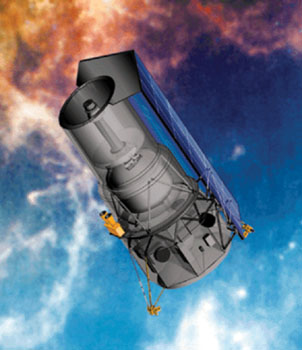 |
|
| NASA's Space Infrared Telescope Facility (top) is in orbit and waiting to cool down before gearing up to do serious science. | |
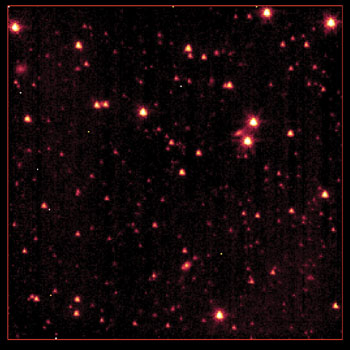 |
|
| This engineering test image (above), taken through one of SIRTF’s three scientific instruments, shows a 5x5 arcminute infrared starfield in the constellation Perseus. |
On Aug. 25, the Space Infrared Telescope Facility (SIRTF) was launched into orbit from Cape Canaveral aboard a Delta-2 rocket. SIRTF’s launch was anxiously followed by two researchers with Berkeley Lab’s Materials Sciences Division (MSD), who have been involved with this NASA project for nearly 20 years. Now, with the successful launch, they expect to soon see images of previously hidden cosmic views they helped obtain.
SIRTF’s images will be captured via a 0.85-meter telescope and three sophisticated infrared spectroscopy tools. One of them, the Multiband Imaging Photometer for SIRTF (MIPS), will provide highly sensitive deep-space probing and mapping at far-infrared wavelengths ranging from 24 to 160 microns — about 50 to 300 times the wavelengths of visible light.
Detectors for two of the three arrays at the heart of MIPS were developed and partly fabricated under the leadership of MSD’s Eugene Haller and Jeffrey Beeman.
“NASA approached us in 1984 asking for a detector that would
be a good absorber of far-infrared radiation but which would generate
very small dark currents in the absence of radiation,” says
Haller, who also holds a faculty position at UC Berkeley.
Says Beeman, “What they were asking for had never been developed,
and we had no means to measure the extremely small signals and dark
current that they were describing.”
Because interstellar gas clouds and space dust effectively absorb visible and ultraviolet photons, observations in the far-infrared portion of the electromagnetic spectrum can reveal objects and phenomenon that would otherwise be invisible to astronomers, such as the history of early star formation and the evolution of galaxies and planetary systems.
SIRTF is the largest infrared telescope ever sent into space, and MIPS is the first true detector system designed specifically for far-infrared wavelengths. For the two detector arrays they helped develop, Haller and Beeman mounted an extensive search of semiconducting materials and found a germanium crystal doped with gallium that had first been grown by Berkeley Lab researcher Bill Hansen in 1970.
To boost the range of far-infrared wavelengths detected, Haller and Beeman subjected some of their gallium-doped germanium crystals to mechanical stress. This changed the crystals’ valence band structure, which enabled them to detect lower energy photons than unstressed crystals.
The unstressed gallium-doped germanium detectors that Haller and Beeman fabricated are deployed in a 32x32 configuration that can image photons at wavelengths of 70 microns. The mechanically stressed crystals are arranged in a 2x20 configuration that can image 160 micron photons. In combination with a 128x128 detector array made from arsenic-doped silicon, MIPS can “see” heat sources radiating at around 20 Kelvin, a glow 100 times more faint than any previous infrared telescope could see.
Because the MIPS detectors are so highly sensitive, they and the
rest of SIRTF’s science instruments have to be cooled down with
liquid helium to a temperature of about 1.5 Kelvin. Otherwise, the
detectors would be “blinded” by their own heat radiation.
Building detectors that could operate at temperatures of near absolute
zero was just one of the many challenges that Haller and Beeman had
to overcome.
“These detectors also had to withstand the violent shaking that occurs during launch, as well as the many Gs of thrust from the Delta-2 rocket,” says Haller.
Another challenge, Haller says, was creating electrical contacts that could operate in such ultracold temperatures. For this, he and Beeman used ion implantation to create heavily doped regions near the surface of the semiconductors that acted as perfect electrical contacts.
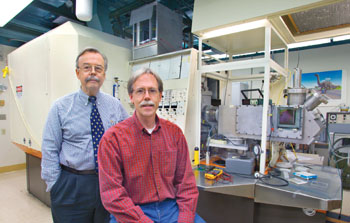 |
|
| MSD scientists Eugene Haller (left) and Jeffrey Beeman developed two of the far-infrared radiation detector arrays aboard NASA’s Space Infrared Telescope Facility, which is designed to capture images of previously hidden celestial objects and phenomena. | |
Haller and Beeman also had to invent low-power calibrators, sources of far-infrared light that can be used to test the detectors before and during the mission. The calibrators allow astronomers to perform measurements that can determine whether a detector’s performance has been impaired by thermal instabilities or radiation damage. They also serve as “IR flood sources” that can help reset detectors after a radiation problem.
“When testing showed that the calibrators would be critical to the success of MIPS, we decided there needed to be redundancy at each usage point in case of a failure during the launch or other problems,” Beeman says. “There’s a total of 10 calibration devices onboard.”
Soon, Haller and Beeman’s detectors will have sufficiently cooled down to begin recording images and the researchers expect success.
“Our detectors and calibrators have been so thoroughly tested,
we’re confident they’ll perform as they were designed
to do,” Beeman says.
From Picasso to J Visas
Key Roles for Head of the International Researchers and Scholars Office
BY D. LYN HUNTER
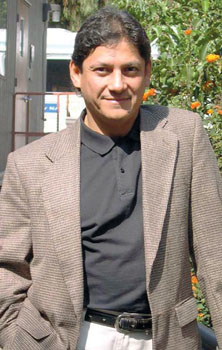 |
|
| Ben
Ortega |
It’s tough to move to a new country without speaking the language, as was the case when Ben Ortega moved to America from his native Peru in 1985. But he got by with a little help from his friends — the Fab Four, that is.
“I grew up listening to the Beatles,” says the manager of Human Resour-ces’ International Researchers and Scholars Office (IRSO). “I would sing along to the records and it helped me understand English a little better.”
Music has always been a big part of Ortega’s life. In fact, for a couple of years, he was a drummer for a Lab-based blues band. But his true passion now lies in the theater.
All The World’s a Stage
It all started back in the late 1980s when, after seeing the proliferation of stand-up comics with their own TV shows, Ortega thought to himself, “I could do that.” He began writing comedy, and then, with the encouragement of some friends, took his act to the stage. He was living in Washington D.C. at the time, working for an immigration lawyer.
“The first time I tried it, I bombed,” he recalls. “But I kept at it, and eventually became pretty well known in the area. After a while, I began hosting comedy shows at local clubs.”
During this time, he was asked to play an alcoholic on a local cable-access program. His first stab at acting was quite successful. The proof? His mother called him in tears after viewing the show, wondering why he never revealed his drinking problem to her.
He put his performing on hold while he pursued a masters degree and worked with international scholars and students at the University of Alabama and, later, at the California Institute of Tech-nology. After living in Pasadena for a couple of years, he finally climbed back onto the stage and started performing again.
A job offer from the Lab brought Ortega to the theater-rich Bay Area in 1999. Since arriving, his acting career has taken off. So far, he has appeared in 17 plays (one of which opened last month at the Onstage Theater in Pleasant Hill), and three films. Ortega has played a wide range of characters, from Pablo Picasso in “Picasso at the Lapin Agile” to Phyllis, a female role (yes, that’s right) in “Sylvia”.
The Day Job
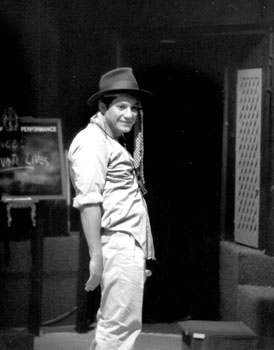 |
|
| Ortega plays drunkard George Hay in the play Moon Over Buffalo. | |
While Ortega is fervent about his acting, he considers it a “very important hobby.” Helping to bring the world’s top researchers to the Lab is an equally satisfying endeavor for him.
The main focus of his five-person office is to prepare VISA documents so that international scientists can come here to work temporarily. To accomplish this, Ortega and his staff must have intimate knowledge of the complex laws, policies and regulations that govern immigration to the United States. These guidelines got even more complicated after 9/11, as the government stepped up background checks on scientists, particularly those from “sensitive” countries like Cuba, North Korea, Iran, India, and China.
Despite these challenges, Ortega and his colleagues have excelled. Virtually every international resear-cher hired by the Lab has arrived here without a hitch. Once here, Ortega’s office helps these resear-chers get oriented to life at the Lab and in the Bay Area. They offer advice and referrals on a variety of topics, such as housing, schools, and social activities, as well as counsel them on their rights as immigrants.
His success assisting international researchers at the Lab is paralleled
by his triumphs on the stage and in film. Says Ortega of his achievements
in both career and hobby, “If you like what you do, it becomes
part of you.”
A Veritable United Nations
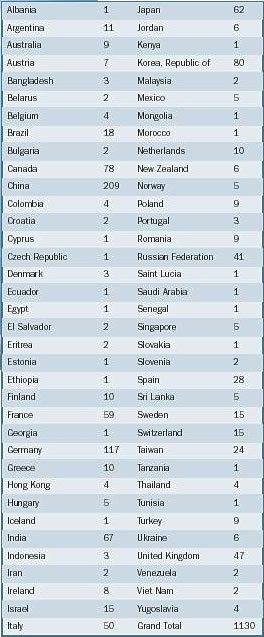 |
From St. Lucia and Eritrea to Malaysia, Morocco and Mongolia, scientists from around the globe come here to work. Currently, there are 1,130 foreign nationals employed at the Lab. The list below shows all the countries represented, and the number of researchers from each nation.
Flea Market
- AUTOS & SUPPLIES
- 98 HONDA CIVIC EX 2-dr coupe, shiny red, 66K mi, cute, runs great,
auto, prem sound, am/fm/cd, rear spoiler, moonrf, $8,800/bo, Eishi,
eendo@lbl.gov, X7140, 381-8375
96 CHEVY S10 BLAZER, teal, 90K mi, 4-whl dr, new ac, am/fm/cassette/cd, all pwr, abs, cruise, leather inter, roof rack, privacy glass, tilt whl, exc cond, $8,000/bo, Deborah or Paul, (925) 429-2431
95 FORD CONTOUR GL, 61K mi, at, ac, ac/fm/cass, new tires, brakes, yell brown, looks new, $3,500/bo, Tennessee, 282-0813 or janet_ford080@yahoo.com
87 T BIRD, 88.6K mi, pwr driver seat, ac, pwr win, no radio, runs fine, well maint, $550, Jonathan, X6572
86 JEEP WAGONEER, 140K mi, new tires, new brakes, $2,000 firm, Kathy, 486-4931, (925) 855-9135
85 G20 INFINITY, 90K mi, new tires, exc cond, $5,500/bo, Karen, X6316 - HOUSING
- ALBANY, spacious 2/2 condo, Park Hill by Eucalyptus, fully furn,
quiet, eleg, sleeps 4 in 3 beds, swim pool, exer rm, rec rm, 2-car
garage, close to food mkt, El Cerrito Plaza, Bart & public trans,
busing to school, Denyse 848-1830, gfchew@mindspring.com
BERKELEY HILLS, bay view, furn rm, 17x15, priv bth/entr, quiet neighbrhd nr UC/pub trans/shops, cooking facil in adj rm, pool table, workout mach, w&d, $850/mo, incl linens, dishes, util, phone, DSL, TV, use of garden/BBQ, no smok/pets, short stays, $300/wk, Carol, 524-6692
BERKELEY HILLS, by wk/mo, quiet furn suite, sleeps up to 3 in 2 bdrm/1bth, quiet, eleg, spacious, bay views, DSL, cable, microwave, walk to UCB, Denyse, 848-1830, gfchew@mindspring.com
BERKELEY HILLS, share house nr Lab, nice furn bdrm, priv bath, decks, views, super kitchen, Asian furn, avail now, Fred, X4892, 841-3552
BERKELEY, 100-yr-old updated brown shingle cottage in Elmwood, 1+ bdrm/1 bth, hardwd flrs, stove, refrig, nice setting, $1,500/mo, unfurn, $1,600/mo, modestly furn, preef short term, avail now, Lara, X7276, lagundel@lbl.gov, Pete, 548-4832
BERKELEY, walk to campus, eleg furn rms & apt, hardwd flrs, PC & DSL include, $950-1575/mo, Paul, X7363, 845-5959, jin.young@juno.com
EL CERRITO HILLS, home to share, own priv 1 or 2 bdrm suites, priv entr, big, clean, newer, quiet, redwoods backyard, easy commute, BART, $750-$950/mo, avail now, 527-5948, Kim, 525-8665, Marty Morimoto
EL CERRITO, 1 very lge bdrm, 1 small bdrm, bthrm w/shower only & kitchenette, sunlight for lge bdrm, hillside of EC , easy access to BART, shops, freeways, peaceful, tree-lined neighbrhd w/schools, playgrounds, nature trails, furn w/ essentials, $1,000/mo, pref mature, responsible, considerate singles, UC connection a plus, will consider more than 1 tenant w/add’l cost, avail 11/1, Pierre, 334-1960
NORTH BERKELEY HILLS, furn 4 bdrm/2 bth house, avail for 6 mo starting mid-1/04, 3-bridge bay view, quiet neighbrhd less than 2 mi from UC, close to downtown, Solano, Tilden Park, bus across str, hardwd flrs, fp, dishwasher, microwave, refrig, w&d, lge family rm, garbage, water & gardener incl, fenced backyard, dogs ok, no smoking, $3,300/mo, $1,500 sec dep, Julie, 524-6357, tomjule@pacbell.net
NORTH BERKELEY, exc location, blocks from grocery store, Cheeseboard, best neighbrhd, gracious house, vis scholar, postdoc, grad, will share, courteous, intelligent, busy people, privacy honored, DSL internet connection avail, weekly housekeeper, foreign visitors welcome, congenial, non-smoking household, Ann, 527-1331
OAKLAND, share home, 1 furn bdrm in 100-old-house, fp, hardwd flrs, deck, laundry, cable + util, great backyard, no pets/ smok, $600/mo, or by week, Andreas, 532-1935
ROCKRIDGE, premium location, furn bdrm in a sunny, spacious, 2 bdrm, hardwd flrs, split level flat, w/d, right off College, 3 bl to BART, 20 min walk to campus, $690/mo +1/2 util, no pets/smok, short term ok, Phillippe, (925) 260-3239
WALNUT CREEK, townhouse nr Bart, 2 bdrm, 2-1/2 bth, end unit w/fp, detached garage, two patios, central ac, in Sunset Park across from Countrywood shopping ctr, $1,500/mo, Bob (925) 376-2211, nbs@value.net
NORTH BERKELEY, lge, sunny, 1 bdrm apt, fully furn, dishes & linen incl, nr UC & Lal shuttle, shops, rest & BART, $1,750/mo, incl util, cable, garbage & local phone serv, no pets/smok, Ada, 237-8399, www.oxford-apartments@comcast.net - MISC FOR SALE
- 17” NEC MULTISYNNC 70 monitor, very good shape, will take
your offer, HP Desk Jet 693C color printer, like new, ask $20, Nanyang,
(650)926-2252, 799-6617, night
FUTON, queen size w/ frame, only 3-yrs-old, $115; portable stereo, Fisher CD player, tape & radio, $22; guitar, Francisco Esteve Acoustic w/case, $108; motor bike, soft saddle bags, probably fits any bike, easy clip on/off, rainproof inner lining, sturdy material, $40 for both; 2 car camping chairs, small but comfy, $10 for both, Geoff, (415) 515-7493, Jon, X5974
PHYSICS TODAY, complete volumes for sale, 1966 - 1990, Vlado Bevc, (925) 837-7612 - WANTED
- HOUSE/PET-SITTER for lovely sun-filled 2 bdrm Albany home nr Terrace
Park, 12/20-1/9/04, wood flrs, laundry, fp, deck & priv back
yrd, nr Solano & Monterey mkt, 3 outside cats & 1 very lge
& friendly outside dog need daily meals & walk or romp in
nearby park, straight exch of housing for pet sitting offered, dep
& refer req, Nick, X6314
AUTOMOBILE to purchase for teenager, must have an auto trans working seat belts, pass smog inspection, in driveable cond & have no major mech issues; dents, scratches & bad paint ok, max price $1,000, Wes, X7353, (415) 898-2084, fax (510) 486-5812
HOUSEKEEPER to work 3 or 4 hours per week cleaning home in Orinda, seek someone who takes pride in having a house look good, refs please, Mike or Sue, (925)254-0609
SF JAZZ TICKETS, great seats, K. Jarrett w/ G. Peacock & J. DeJohnette, Sun, 8 pm, 11/09, $110/pr, Erika, X4930, 848-8173
SF OPERA TICKETS, balc pair, 2nd row ctr, Barber of Seville, Sat eve, 10/25, Don Carlos, 11/1, $124/pr, Paul, X5508, 526-3519
VACATION
- NORTH LAKE TAHOE house at Kings Beach, 3 bdrm/2bth, sleeps 6,
full kitchen, liv rm & din area w/fp, quiet cul de sac, great
neighbrhd, 1 mi to public beach, $125/night, 2 nights min, $75 cleaning
fee, $675/week, Vlad or Linda, 849-1579, lmoroz@earthlink.net
Tri-Lab Recruiting Session Draws a Crowd
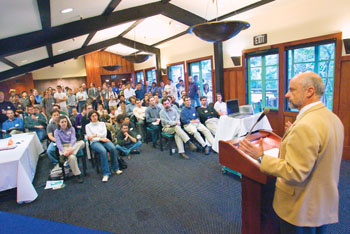 |
Berkeley Lab Deputy Director Pier Oddone (pictured on the right)
and colleagues from the other two labs spent the day describing career
opportunities in science. The program culminated with a reception
at the Faculty Club. The collaborative recruitment initiative will
continue at UC Santa Barbara and UC San Diego later this year.
New Breast Cancer Center Investigates Bay Area Mystery
BY DAN KROTZ
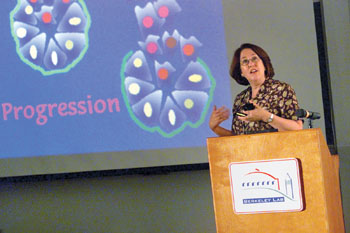 |
|
| Mary Helen Barcellos-Hoff | |
For more than 30 years, the Bay Area has had higher breast cancer rates than the rest of the country. Now Berkeley Lab joins a center launched earlier this week that will explore why.
The Bay Area Breast Cancer and the Environment Research Center will study the possible environmental links to breast cancer and address continuing concerns about the high incidence of breast cancer in Marin and San Francisco counties. Life Sciences Division director Joe Gray and staff scientists Mary Helen Barcellos-Hoff and Paul Yaswen join other researchers from UC San Francisco, Kaiser Perman-ente, Marin Breast Cancer Watch, and the San Francisco and Marin County Departments of Health.
The Berkeley Lab team will contribute to the basic science component of the center’s research, in which animal models will be used to study mammary development.
“Human and animal data suggest that exposure to carcinogens such as radiation during puberty increases the likelihood of cancer later in life,” says Barcellos-Hoff. “We want to learn what is specific to puberty that makes girls susceptible.”
The center will also conduct a prospective study of Bay Area girls aged seven or eight to identify environmental exposures in young girls, and to observe the interplay between genetics and environmental exposures.
Headquartered at UCSF, this is one of four centers funded through a new NIH initiative that will study the impact of prenatal-to-adult environmental exposures that may predispose women to breast cancer. The other centers are based at the University of Cincinnati, Fox Chase Cancer Center in Philadelphia, and Michigan State University in East Lansing. They are supported by the National Institute of Environmental Health Sciences and the National Cancer Institute at $5 million a year over seven years for a total of $35 million. Also participating is Christine Erdmann, a University of Michigan professor who also holds a position in Berkeley Lab's Environmental Energy Technologies Division.